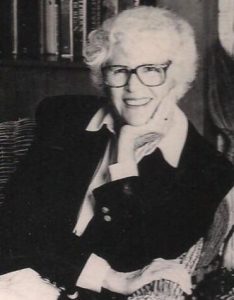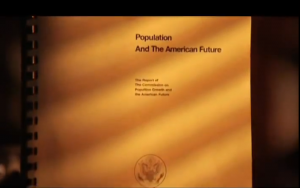
Guttmacher Institute founder Frederick Jaffe described as “very abusive” by longtime colleague


Dryfoos begins the interview describing her childhood and then admits to Zane that although she was raised religious she claims that she was eventually “turned off” to religion at a young age, “I became a non-believer at a very early age, and I’ve never figured out how I figured that out, but I did. I was just totally turned off.”
After Dryfoos finished college, traveled a bit and got married she had one child but could not have more. Her husband George Dryfoos, did not want to adopt. In the early 1960’s Dryfoss said that three of her friends got together and started a group called, Research, Writing and Editing Associates. Eventually Dryfoos ventured out on her own, analyzing the 1960 census and writing research briefs. This is when her connection to Planned Parenthood’s research arm (at that time) began. As Dryfoos tells it:
Dryfoos recounted how she met Population Council consultant and Margaret Sanger Award winner Christopher Tietze. According to a report in the New York Times Tietze believed that biological life begins at conception, he also believed that a fetus ”deserves the respect and protection that we accord people” only ”when it has become capable of surviving.” The times then quotes Tietze as saying:By about ’62 or ’63, one of these research briefs — through a connection of one of my pals –got to a guy who was on the research committee of national Planned Parenthood.I showed how you could use the census to project the need for childcare, low-income housing, and family planning; and it was the family planning one — that got picked up.
In addition to Tietze, Dryfoos met American Eugenics Society member Charlie Westoff was was also a member of Planned Parenthood’s National Advisory Council. Westoff would eventually become the Executive Director of President Richard Nixon’s Commission on Population Growth and the American Future which opened up the flood gates of funding to Planned Parenthood. This Commission was headed by John D. Rockefeller and applauded by former Planned Parenthood vice president Fredrick Jaffe, who also influenced Dryfoos.”At present,viability is assumed by most doctors to be reached at about 24 weeks from the onset of the last menstrual period. However, some genetic defects may not be discovered until late in pregnancy. Is such a fetus viable? Is that meaningful life? I think not.”

Dryfoos explains meeting these three:
By 1970, Dryfoos recalled how The Population and Family Planning Act was passed and that she got to know some of the people on the research committee.So pretty soon, I was summoned before this research committee, which was very prestigious in those days. It had, like, Ashley Montague and — oh, people you wouldn’t know: Christopher Tietze and Charlie Westoff (who’s still alive and still very much a leading demographer). So I met with them, and here I was, this cute young woman who had written all this stuff.So they were particularly interested in my idea of estimating the need for family planning through the use of the census data. One guy named Fred Jaffe was vice president of national Planned Parenthood for public information. He was trying to get Planned Parenthood and the rest of the world to recognize that there had to be federal funds for family planning. He saw in me this tool for coming up with a method of describing this need in a very researchy, not at all emotional may. It had to do with low-income women. It in addition to the census, was actually based on estimates of fecundity and sterility. Overtime, it became a work of science that was published in the American Journal of Public Health.
So interested that after going back to college, Dryfoos was recruited to work for what would become the Guttmacher Institute where she remained for the next 15 years. She described Alan Guttmacher as a “terrible administrator” who “was talking about abortion” and “knew how to flatter people” which, according to Dryfoos led to him being the figurehead. There she met Frederick Jaffe, the organization’s first president, who once authored a very controversial memo that advocated eugenics through compulsory sterilization and abortion.They invited me to go to the Population Association meetings, and I got pretty interested in that field.
Dryfoos then told Zane how abusive Jaffe was. She also claimed the Guttmacher Institute president was committed to family planning as “a poverty issue.”So I graduated, which then gave me the qualifications to do what I would have done anyway. Fred Jaffe hired me before I even got the degree. He was just waiting for me to get out, because he was putting together money for a new agenda. Alan Guttmacher, by then, was the president of the Planned Parenthood, and Fred was preparing the way to start something which is now the Alan Guttmacher Institute, but [then] it was called the Center for Family Planning Program Development. He said, “You’ve got to come and work there.” So I said, “Fine.
Adding later in the interview that :He was a very interesting character. He should be written about. He’s a very important character. I’m not sure that there would be –I don’t know whether there would be a family planning program the way it was or whether there would have been legislation without him. He was also a total bastard. He was, as my husband would always say, he was like a German who was either at your throat or at your feet.He was very abusive. He was totally directed on one issue. He was just totally committed to this cause of family planning, as a poverty issue. He was an old leftist, an old union guy.
Dryfoos bragged that a formula she authored was used by Jaffe at Guttmacher as the reason family planning funding was so openly received.everybody in the national organization of Planned Parenthood hated him because he was so arrogant and mean, and these volunteer ladies really hated him, the ones that he didn’t sleep with, I might add. There was a lot of that stuff going on. But, I mean, this was the early days of Planned Parenthood as well. So he was a controversial character, but he was just so driven, and he knew how to drive Congress as well…
What did they do with all that money? Well according to Dryfoos, they started the McDonald’s of centralized family planning services.And, you know, we developed the most elaborate statistical analyses over some little point, like how many trained nurses we need in 1972 versus 1973 for family planning, and where they should be trained. But I think he was right. I think it was a very good strategy to come up –to get Congress, hook Congress with all this detailed planning. And he got all this stuff written into the legislation that not only provided money for family planning in clinics. They had to plan — there had to be a national plan, and the national plan was based on the Dryfoos formula for estimating the need family planning. So the money was allocated according to that formula That’s why we would keep tinkering with it, just because it was fun. But I could tell you a neighborhood — how many family planning patients there might be, with this thing. So we used it like magic. And this Center was very successful. It got huge federal grants and a big Kellogg [Foundation] grant, and we had a lot of money.
Dryfoos talked about the day she told Jaffe she was quitting, noting that instead of selecting a replacement she suggested he was sexist and chose a graduate student with “great legs.”We got Model Cities money and OEO [Office of Economic Opportunity] money, and we would go into a community and develop a plan for coordinated family planning. It’s funny, because this is sort of the first iteration of this whole idea of services in one central location. But this idea was that they should form a corporation, kind of, at the community level and figure out where all the family planning programs should be and centralize the administration and the training and the supplies and all that stuff, and get the delivery of the services out to the neighborhood. As we always said, it was just like McDonald’s. It was the same theory. And that’s what we did. And we did that in a lot of communities. Eventually, I did it in a number of states and I had sixteen people working for me.
In 1978, the year Frederick D. Jaffe died, despite his conduct, Planned Parenthood honored Jaffe, by giving him their top award, the Margaret Sanger Award.I gave him a list of, like, twenty people who would be great, and by then he could pay a huge salary. In fact, he was paying me a huge salary. And could have had his pick because it was considered a good job. Instead, he hired a graduate student sort of type.When I asked him, he said she had great legs. And that might have been the truth. I mean, he might have just wanted a pretty young thing around. Strangely enough, she’s still there, and this is twenty years later…He [Jaffe] was just such a pain.
Read the full Dryfoos interview here.
Source: LiveAction News









No comments:
Post a Comment